History Exhibition Room 2
Update date: March 16, 2018
History Exhibition Room 2 displays historical materials from the Meiji era to the present day of Inagi City.
| Exhibition theme | era etc. | Exhibition Contents | |
|---|---|---|---|
| 1 | Meiji Restoration and Inagi area | Meiji period | The Meiji Restoration era, changes in administrative divisions, land tax revisions, etc. |
| 2 | Changes in modern education | Meiji and Taisho era | Changes in education during the Edo period and modern education systems such as elementary schools |
| 3 | Development of private school education | Meiji and Taisho era | Zensuke Kubo's Sensei Juku and Yuzo Omata's Wasan Juku, etc. |
| 4 | Birth of Inagi Village | Meiji and Taisho era | Birth of Inagi village, transfer of Mitama to Tokyo prefecture, Sino-Japanese and Russo-Japanese wars |
| 5 | The era of Taisho temocracy | Taisho/Showa era | Great Kanto Earthquake, Nambu Line, Tamagawara Bridge, modernization of life |
| 6 | The era of war and Inagi Village | Showa Era | Impact of the Great Depression, Tama Gunpowder Factory, etc. |
| 7 | Postwar reconstruction and agriculture in Inagi | Showa Era | Agrarian reform, establishment of agricultural cooperatives, reconstruction of agriculture |
| 8 | Young people and women in the early postwar period | Showa Era | The establishment and activities of the Youth League and Women's Association |
| 9 | From Inagi Village to Towns/Cities | Showa/Heisei era | Merger of Oshidate area, transition to Inagi Town and Inagi City |
| 10 | History of the Former Inagi Fifth Elementary School | photos and memorabilia | History, photos, and memorabilia of the closed former Inagi Daigo Elementary School |
| 11 | History of the former Inagi Daiichi Elementary School | photos and memorabilia | History, photos, and memorabilia of the closed former Inagi Daiichi Elementary School |
History Exhibition Room 2
Inagi after the Meiji period
Meiji Restoration era
In the Edo period
Meiji Restoration Exhibition
Changes in modern education
The modern education system was established in 1872.
Inagi Elementary School flag
Exhibition of changes in modern education
Development of private school education
During the Meiji period, private school education was also popular in parallel with elementary school education.

Materials for Gokujuku
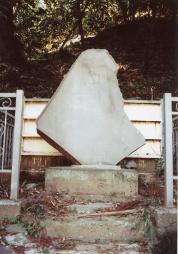
Monument to Yuzo Omata
Birth of Inagi Village
In 1889, six villages merged to form the village of Inagi. At that time, the village of Oshidate was a newly established village.
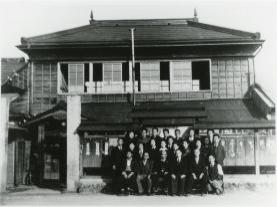
Inagi village office and staff (photographed around 1950, provided by Junmasa Tanaka)
Monument to the Russo-Japanese War
The Taisho Democracy Era
In the Taisho era, people's lives gradually became modernized. Although it suffered major damage in the Great Kanto Earthquake of 1922, the Nambu Railway was opened from Kawasaki to Daimaru in 1928, and the Tamagawara Bridge was also opened in 1933. Around this time, modernization of life progressed, including electric lights, telephones, and postal services.
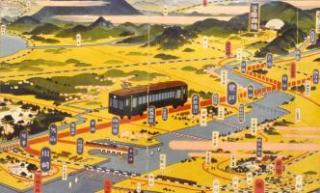
Nambu Railway opening guide map
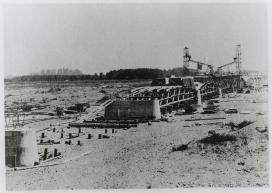
Construction work on Tamagawara Bridge (photo taken in 1930, provided by Jiro Kawashima)
The era of war and Inagi Village
As the country entered the age of war, its influence was felt even within the village. In Daimaru, the army

Pyrotechnic factory Tama gunpowder factory
Drawings by school children (Ikoji Temple)
Postwar reconstruction and agriculture in Inagi
After the war, land reform was promoted under the leadership of GHQ. An agricultural cooperative was established, and Inagi's agriculture gradually recovered. Inagi's pear cultivation, which had declined during the war, is gradually making a comeback.
Display of pear labels, etc.
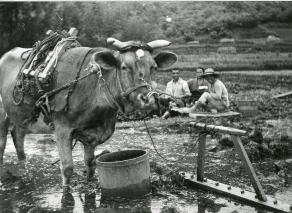
Farming work using cows (Photo taken in the 1950s, provided by Yoshiko Nabeshima)
From Inagi Village to Towns/Cities
In 1949, the Minamioshitate area, with which the two had long-standing ties, was merged into Inagi Village. In 1955, due to population growth, the town became Inagi Town. In 1971, Inagi City was established as the 25th city of Tokyo. The population at this time was 36,800.
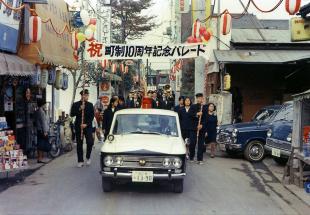
10th anniversary parade
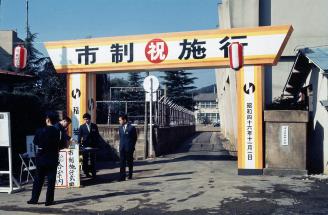
Commemoration of city organization enforcement
History of the former Inagi Fifth Elementary School and Eighth Elementary School
Friend Hirao, where the local information room is located, was originally Inagi Daiichi Elementary School. In April 2002, the Eighth Elementary School and the Fifth Elementary School were merged to become Hirao Elementary School. We will introduce the history of both elementary schools that have closed down through photos, memorabilia, and other materials.
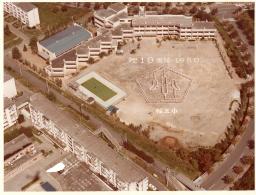
Inagi Daigo Elementary School 10th Anniversary

Inagi Daiichi Elementary School 10th Anniversary Ceremony
Inquiries regarding this page
Inagi City Education Department Lifelong Learning Division
2111 Higashi-Naganuma, Inagi-shi, Tokyo
Phone: 042-377-2121 Fax: 042-379-0491







